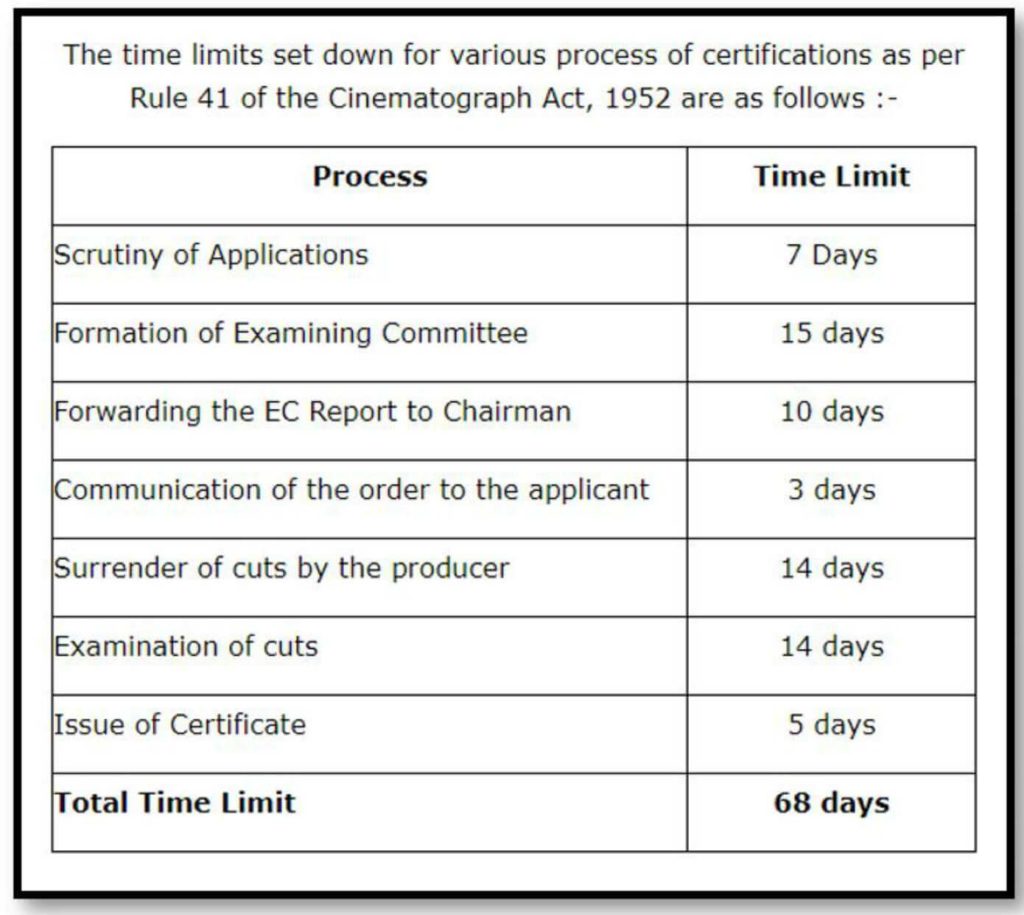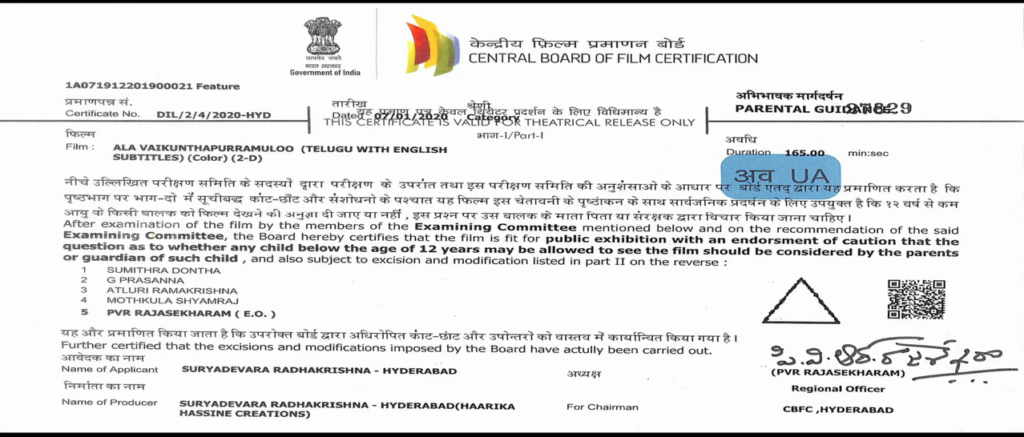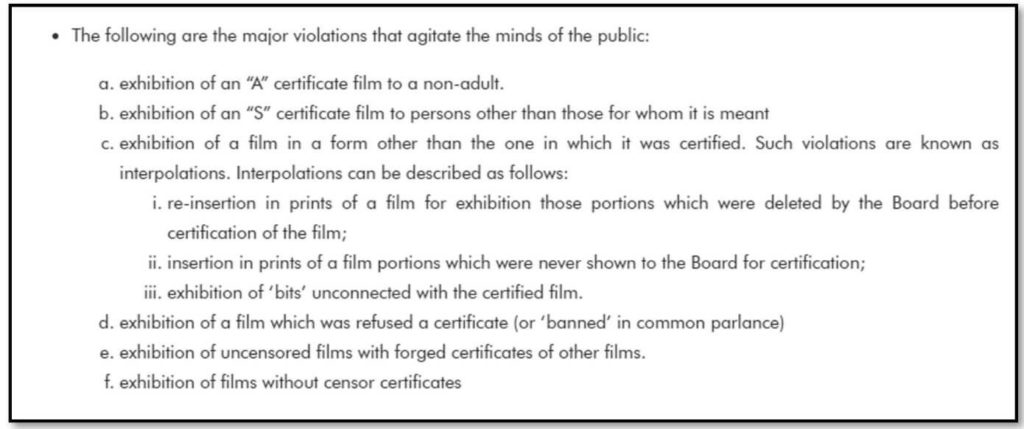The CBFC or the Censor board has recently unveiled a new design of the censor certificate. But what is new about this certificate? Here is a detailed explainer.
Of late, have you observed anything different in the CBFC certificate (censor certificate) displayed before the movie? If not, pay attention at the theatres next time. The Central Board of Film Certification (CBFC) has introduced a new design of the censor certificate.
But how is the certification done, what the guidelines are and how is the new certificate different? Here is a detailed explainer.
Cinema has a strong impact on society and individuals. Some content may not be relevant to all types of audiences. Moreover, the impression created on a child’s mind by certain type of content must also be considered. Thus, it is necessary for a body like the CBFC to preview the content and accord a relevant certificate. The certificate decides who all can watch the movie and whether the movie could be open for universal public viewing.
Cinematograph Act, 1952 constituted the Central Board of Film Certification
The CBFC, which is commonly referred to as the ‘Censor Board’ is constituted under the Cinematograph Act, 1952. The guidelines for certifying movies are provided in this act and in the Cinematograph (Certification) Rules, 1983. These guidelines are revised from time to time.
Initially, only two categories were listed- ‘U’ for unrestricted public exhibition and ‘A’ for exhibition restricted to an adult audience, that is, those above 18 years of age. Later, in June 1983, two more categories were added- ‘UA’ which called for parental guidance for children below 12 years of age and ‘S’ for exhibition restricted to specialized audiences such as doctors and scientists.

CBFC must ensure that no offensive content is present in the movie
As per the Cinematograph act, a movie must not be certified by the board if any part of it is against the interest of sovereignty and integrity of India, security of the State, friendly relations with foreign States, public order, decency or involves defamation or contempt of court or is likely to incite commission of any offence.
As per the act & relevant rules, CBFC must also ensure that the film is sensitive to values and standards of society. The medium of film must provide clean and healthy entertainment. Artistic expression and creative freedom should not be unduly curbed and antisocial activities must not be glorified or justified in the movies- be it alcohol consumption or smoking. Scenes involving sexual violence against women including rape, attempt to rape, or molestation must be avoided or should be reduced to a minimum. Making fun of physically and mentally challenged persons must also be avoided. Visuals or words which promote communal, obscurantist, anti-scientific and anti-national attitude should not be presented.
Not only movies but the material used for publicity such as trailers and posters should also be previewed by the board. Even the video and CD versions of film require certification. Only certified movies can be screened in theatres and be shown on cable TV.
Time limit for the whole process of certification is 68 days
In order to get a movie certified for public exhibition, the applicant must submit a form, fees, requisite documents and film material to concerned regional centre of CBFC. The process is now made simpler and the application can be submitted online along with the requisite fees.
An examining committee is then set up with a CBFC member and an advisory panel member, either of whom shall be a woman, for short films. For feature films, a committee of four members is set up with at least two women. All members submit their reports to the chairperson after previewing the movie who may refer it to a revision committee on his own or as per the applicant’s request. It is the duty of the applicant to make the edits if any as suggested by CBFC. In case the applicant is not satisfied with the board’s order, they can appeal to Film Certification Appellate Tribunal. The Cinematograph rules prescribe 68 days for the whole process.

New logo and film certificate were unveiled in August 2019
On 31 August 2019, the new logo of CBFC and the new design of the film certificate were unveiled. The chairman of the board, Prasoon Joshi, who is also an eminent lyricist stated that the new certificate had to be interactive and should reflect the modern digital world. The implementation of the new certificate design across the nine regional offices of the board was announced on 9 January 2020 through a press release. The new logo of CBFC unveiled in August 2019 is given below.

Certificate must be shown for a minimum 10 seconds before the film is screened
The following information is given on the certificate issued by the CBFC.
- Name of the film along with language
- Whether it is colour or black and white
- Type- 2D or 3D
- Duration of the movie in minutes
- Certificate number & year of certification
- Location of censor board office where the certificate is issued
- List of members of censor board who were a part of examining committee
- Name of the applicant & the producer of the movie
The certificate may also contain a triangle symbol which indicates that certain edits (cuts) were made to the movie. This symbol is absent for those movies where no edits are made.
All this information is available in Part-1 of the certificate. Part-2 of the certificate is usually available only for movies with suggested cuts or edits. It is mandatory that part-1 of the certificate be shown on screen for at least 10 seconds before the movie is screened. Both parts of the certificate must also be displayed prominently in the theatre lobby.
New certificate comes with a QR code that redirects users to CBFC website
The new certificate is simple, user-friendly, and more visually appealing. Unlike the old certificate, the new one comes with a QR code which the audience can scan using their smartphones to get more details on basic certification of the movie in the CBFC’s website. If a triangle is present near the QR code, it indicates a suggestion of cuts to the movie.
The following is the sample certificate of the Hindi dubbed version of Robert Downey Jr.’s movie Dolittle, as given in the board’s website. This movie, however, did not have any cuts.

The basic certification details on the website include the film name, language, duration, applicant name (who applied for certification), producers, name of the signatory (here, Prasoon Joshi), and name of EO (Examining officer) or PO (Presiding Officer) as explained earlier.
Below is the new certificate of a Telugu movie released recently. Edits (cuts) were suggested to this movie and hence one sees a triangle symbol on the certificate.

Further, one gets access to three more links-
- A short synopsis of the movie
- Cast and credit details- Names of director, main and supporting actors and producers
- Trailer or promo video of the movie
Apart from this, one also has the option to check out all the edits (cuts) made in the movie or from its trailer as per the censor board’s orders.
All these details can also be accessed from the CBFC website’s search section.

Violation of rules can be reported
Penal enforcement of the provisions of the Cinematograph act falls under the purview of State. However, at times, it is possible that some forms of violation go unchecked. To tackle this problem, the board has empowered the audience to report violations of film certification rules directly to the CEO of CBFC. The list of violations is also available on the website. A few instances of violation include exhibition of a movie to those restricted, insertion of scenes which were banned, or even screening of scenes that were not shown to the board at the time of preview. The penalty for violation involves a fine and/or imprisonment based on the offence.



